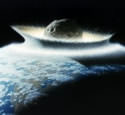
Image credit: NASA
Astronomers announced earlier last week that they had found an asteroid that could strike the Earth in 2019. More astronomers brought their equipment to bear on Asteroid NT7, however, and were able to provide enough trajectory data that NASA has eliminated the possibility of a collision in 2019; although, 2060 could still be a possible impact year (astronomers will probably rule that out eventually too). The asteroid is 2km across, so if it does ever strike the planet, it could cause significant damage.
Asteroid 2002 NT7 currently heads the list on our IMPACT RISKS Page because of a low-probability Earth impact prediction for February 1, 2019. While this prediction is of scientific interest, the probability of impact is not large enough to warrant public concern.
Discovered on July 9, 2002 by the LINEAR team, asteroid 2002 nt7 is in an orbit, which is highly inclined with respect to the Earth’s orbit about the sun and in fact nearly intersects the orbit of the Earth. While the orbits of Earth and 2002NT7 are close to one another at one point in their respective orbits, that does not mean that the asteroid and Earth themselves will get close to one another. Just after an asteroid like 2003 qq47 is discovered, the limited number of observations available do not allow its trajectory to be tightly constrained and the object’s very uncertain future motion often allows a very low probability of an Earth impact at some future date. Just such a low probability impact has been identified for February 1, 2019 and a few subsequent dates. As additional observations of the asteroid are made in the coming months, and perhaps pre-discovery archival observations of this object are identified, the asteroid’s orbit will become more tightly constrained and the future motion of the asteroid will become better defined. By far the most likely scenario is that, with additional data, the possibility of an Earth impact will be eliminated.
This is an example of the type of scenario that we can expect as some types of near-Earth objects are discovered. For some objects, their uncertain initial orbits cannot be used to immediately rule out future very low-probability Earth impacts, but when additional observations are used to refine the initial orbit, these low-probability Earth impact possibilities will go away. Other recently discovered near-Earth asteroids will be added to the Risk page until their orbits are refined and they are then dropped off the list of closely watched objects. This is how the system is expected to work and any initial indication of a low-probability Earth impact followed by a removal of that event from our IMPACT RISKS tables should not be considered a mistake. It is a natural result of the on-going process of monitoring the motions of near-Earth objects.
Original Source: NASA News Release

Dear Fraser,
I read an alarmist report yesterday about NT7 in an Austrian newspaper while on a skiing holiday.
Thanks for UT for providing sane and knowledgible info.
I think the report was written on the back of TU24 which caused some consternation on You Tube and elsewhere.
Thanks a lot for your regular comments and info on UT. Great service to the space orientated community.
Regards
David
David
Asteroid in 2019 will be too close to call. I say it will hit 50/50